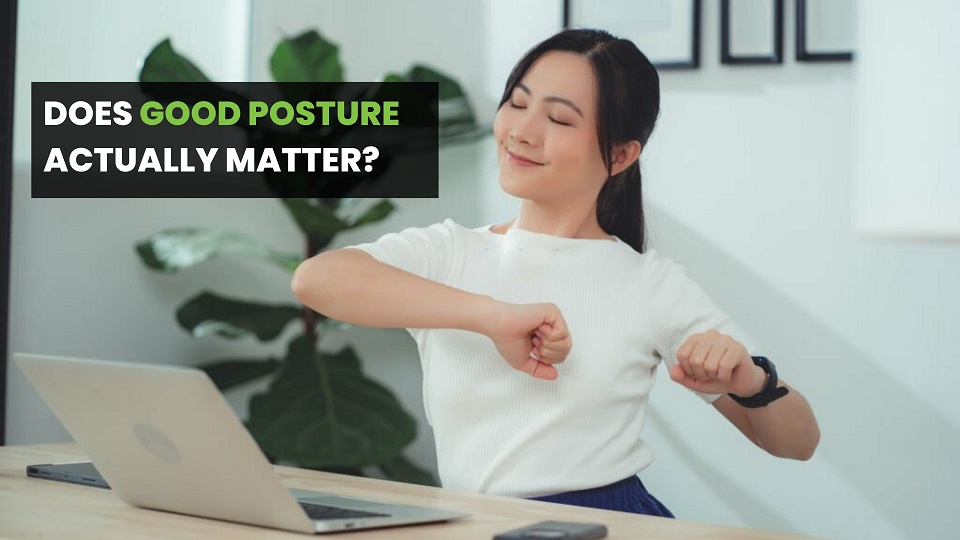Have you ever seen runway models walking on the ramp with such confidence and releasing glamour at every step? The way they walk, each body part is moved in a particular direction and continuity, the way their dresses adjust their way into their bodies; that’s the type of posture we’d all love to maintain!
And posture isn’t all about the visuals and glamour; posture affects one’s complete life. From spine health, proper muscle alignment, balanced blood flow, and reduced sedentary behavior to an individual’s complete and confident look, good posture holds everything under its umbrella! It has also a significant connection between posture and lower back pain.
 In this article, we’ll learn all about posture and get into the details of good posture vs bad posture. Here’s what we’ll learn in this article:
In this article, we’ll learn all about posture and get into the details of good posture vs bad posture. Here’s what we’ll learn in this article:
- The Importance of Good Posture
- Difference Between Good Posture and Bad Posture
- Clearing the Air Between Facts and Opinions Related to Good Posture
- Good Posture Reduces Back and Neck Pain
- Poor Posture Affects Digestion
- Good Posture Gives Confidence
- Poor Posture Disturbs Sleep
- Good Posture Improves Spine Health
- How to Correct Your Posture?
- Exercise
- Yoga
- Posture Correcting Belts
The Importance of Good Posture
Posture plays a significant role in our lives. You must have heard from your older ones to sit properly, sit like a lady, don’t slouch, etc. They were all speaking about the same context to maintain a good posture.
Keeping a good posture has more benefits than only one. It surrounds your life structurally, anatomically, biochemically, and in many other ways.
A good posture can help you stand, sit, walk, and move beautifully, stay active, prevent injuries, have athletic support, stay focused and energized, and live an overall healthier life.
Research by the American Chiropractic Association shows that over 31 million Americans suffer from poor posture. This poor posture can drastically bring negative things in their lives, such as health concerns, pains, aches, muscle strains, and even muscle and ligament tears.
Difference Between Good Posture and Bad Posture
You can judge your posture as good or bad in many ways. Let us help you differentiate between both. According to Harvard Health, a good posture is proper body alignment, such as;
- Your chin is parallel to the floor.
- Keeping your shoulders even and equal to each other
- Straight and neutral spine (no tilts, slouches, curving, bending, or arching to either side)
- Setting your arms at your sides straight with elbows straight and even
- Your Abdominal muscles are braced optimistically
- Hips even and eased
- Knees even and pointing straight ahead
- Body weight distributed evenly on both feet (not bending even a little bit on either side)
Clearing the Air Between Facts and Opinions Related Good Posture
We’ve all heard many rumors, myths, opinions, and so-called facts about posture. What to trust is making us question everything!
Let’s have a detailed look at the popular facts and opinions and see what science says about normal posture vs bad posture.
1. Good Posture Reduces Back and Neck Pain
The moment you feel back or back pain and get to your local physician, the first question they ask is, are you sleeping comfortably? Or they could look at your sitting position and figure out your posture positioning. It’s because the back and neck are directly affected by posture.
To avoid, prevent, and reduce back and neck pain, it is advised to sleep on a comfortable (not too stiff, not too soft mattress) bed, do some posture-correcting exercises, and sleep with a proper posture.
According to research[1], improvements in postural awareness are directly linked with reduced pain in patients with spinal/shoulder pain.
2. Poor Posture Affects Digestion
A study[2] was done to see the postural effect on gas and bloating. The results showed that people had a faster gas transit in an upright sitting position than in a supine position where they were lying down facing the sky after eating.
Also, you may have noticed that if you get into a slouchy position or lay on your bed after eating, your stomach starts bloating or getting a heart-burning sensation.
It’s the acid reflux that you feel triggered by your stomach. It happens when you sit in a poor posture after having a meal, leading your stomach acid and food to squirt back to the esophagus in the wrong direction.
3. Good Posture Gives Confidence
Like the runway models, with good and improved posture, you’ll feel more active, beautiful, confident, and positive while performing your daily activities.
Research[3] also proves that sitting in an upright position can help you alleviate stress, maintain self-esteem, reduce negative mood, and increase positive mood, more arousal compared to a slumped posture.
Some people might question why bad posture is comfortable. It’s because your body naturally and lazily finds the path to sit and lay with the least resistance, such as a slouchy sitting position. When there is no resistance, there’s more temporary comfort!
4. Poor Posture Disturbs Sleep
After a tough and hectic day of overloaded work stress and exhaustion, people rarely think about spinal health when they jump into their beds. The only thing in mind is comfort! However, that comfort might not last long and invite a greater evil called back pain.
Good vs bad neck posture, back posture, and overall body posture greatly affect your sleep quality. Research[4] findings on university students also support that poor sleep quality is associated with a deterioration of postural control.
Stop sleeping on your stomach, as it is the worst possible sleeping position. In fact, you can sleep on your back or the side while alternating sides to maintain spinal alignment and keep a good sleeping posture.
5. Good Posture Improves Spine Health
Is bad posture bad for the spine? Yes! The spine is everything in the human body! It’s the basic core energy source from which the whole body channels energy. Your spine must always be in an optimal and comfortable position to stay in good health and support complete body functioning.
Tilts, curves, slouches, bending, or irregular continuous motions can move the spine out of place and invite several health concerns and diseases. You must stabilize[5] your spine’s muscles and joints to achieve balance from an incorrect posture.
How to Correct Your Posture?
There is no need to get stressed because the good news is you can correct your posture using the following ways. Read below to find out!
A. Exercise and Yoga
Exercise and yoga are the key solutions to solving your postural problems. They’ll help you strengthen and stretch the upper back, chest, and core muscles and align the spine in a balanced position. You can get yourself enrolled in a spinal evaluation, mobilization and stabilization exercise, and yoga programs that will help you straighten and align your spine and maintain a healthy posture.
Also, you can try at-home exercises such as child’s pose, forward pose, cat-cow, standing cat cow, different types of planks, pigeon pose, and many others to correct your posture.
B. Posture Correcting Belts
Posture correctors have taken over the internet and social media in a short amount of time. The thought might cross your mind: are posture correctors good or just rumors? The answer is YES, they are!
They work in two ways; aligning and training your body to allow your spine to sit comfortably and appropriately.
Conclusion
A good posture matters! It should be on the top of the priority list. The following signs indicate that you should start exercising and getting proper support from a posture corrector:
- Your muscles are continuously aching
- You’re waking up with back pain,
- You can’t bend easily without holding your back and knees
- Or you feel like your body is out of alignment
By wearing a posture correction belt, when you slouch or sit in an inappropriate position, the belt will let you know your movement by resistance. Read the complete article to learn more about good posture vs bad posture sitting, lying, and standing positions and their effect on our lives.
References:
[1] Cramer, H., Mehling, W. E., Saha, F. J., Dobos, G., & Lauche, R. (2018). Postural awareness and its relation to pain: validation of an innovative instrument measuring awareness of body posture in patients with chronic pain. BMC musculoskeletal disorders, 19(1), 1-10.
[2] Dainese, R., Serra, J., Azpiroz, F., & Malagelada, J. R. (2003). Influence of body posture on intestinal transit of gas. Gut, 52(7), 971-974.
[3] Nair, S., Sagar, M., Sollers III, J., Consedine, N., & Broadbent, E. (2015). Do slumped and upright postures affect stress responses? A randomized trial. Health Psychology, 34(6), 632.
[4] Tanwar, T., Veqar, Z., Ghrouz, A. K., Spence, D. W., & Pandi-Perumal, S. R. (2021). Is poor sleep quality associated with a deterioration in postural control?. Sleep Science, 14(3), 207.
[5] Barassi, G., Di Simone, E., Galasso, P., Cristiani, S., Supplizi, M., Kontochristos, L., … & Giancola, O. (2021). Posture and health: are the biomechanical postural evaluation and the postural evaluation questionnaire comparable to and predictive of the digitized biometrics examination?. International Journal of Environmental Research and Public Health, 18(7), 3507.



 (3 votes, average: 3.33 out of 5)
(3 votes, average: 3.33 out of 5)









